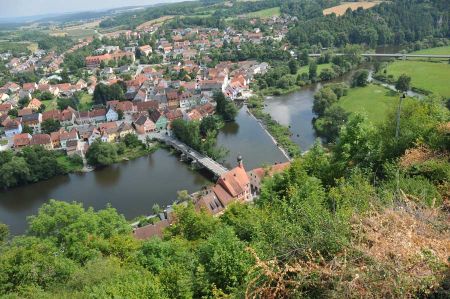Bike tour to Kallmünz - Camping Pielenhofen at Naab river
- Written by Portal Editor
As already announced, there should be further discussions about the German-Turkish literature and encounter festival in Regensburg, which also included the presentation of our project vehicle.
After short research and some local contacts, we decided to go to the campsite in Pielenhofen an der Naab. In addition to the immediate proximity to Regensburg, which can be easily reached by bike along the Naab and later the Danube, it was also the Naab itself and its immediate vicinity with its historic towns and castles that encouraged us in our decision.
 In the early afternoon we arrived at the Pielenhofen campsite, which, despite its not inconsiderable size and frequented, turned out to be an idyllic spot right on the banks of the Naab. As soon as we arrived, we were able to see children swimming happily in the Naab, canoeists and anglers passing by along the river bank. When the bikes were ready for use a little later and a first short trip to the campsite and to the village of Pielenhofen was completed, our first impressions were confirmed: despite frequently changing guests who stopped here on their way south due to the proximity to the motorway, peace and security, very helpful and competent staff, in short, nothing was missing to enjoy our stay next to work.
In the early afternoon we arrived at the Pielenhofen campsite, which, despite its not inconsiderable size and frequented, turned out to be an idyllic spot right on the banks of the Naab. As soon as we arrived, we were able to see children swimming happily in the Naab, canoeists and anglers passing by along the river bank. When the bikes were ready for use a little later and a first short trip to the campsite and to the village of Pielenhofen was completed, our first impressions were confirmed: despite frequently changing guests who stopped here on their way south due to the proximity to the motorway, peace and security, very helpful and competent staff, in short, nothing was missing to enjoy our stay next to work.
Experience in handling the mover attached to the caravan made it easy to bring the vehicle into the desired position, which is sometimes difficult to manage with personal power alone due to the sloping terrain. The site was quickly set up, the satellite antenna aligned for internet access, so that the daily mail could be processed and initial contacts made with the neighbours, who of course were interested in the background of the project because of the Roman road maps on the caravan.
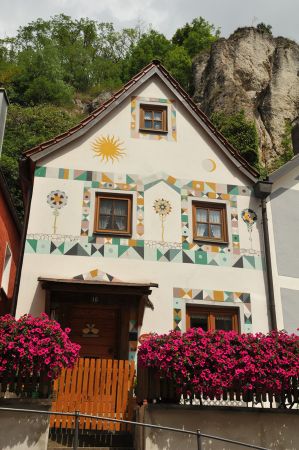 The very next morning we set off on our bikes in the direction of Kallmünz, always following the course of the Naab and well away from the main road.
The very next morning we set off on our bikes in the direction of Kallmünz, always following the course of the Naab and well away from the main road.
Thankfully, we had received a map from the reception on which the route, which was at least 17 kilometres long, had been drawn.
So we first reached Pielenhofen, then Kleinduggendorf, Grain am Berg and finally Kallmünz, whose name alone indicates a coin minting site.
Even the ride to Kallmünz was a relaxed bike ride with various breaks for photos and to view the wonderful flora and fauna along the Naab, a river system of various headwaters totalling 165 kilometres in length, whose water catchment area covers an impressive 5,225 square kilometres, with all the water flowing into the Danube flows.
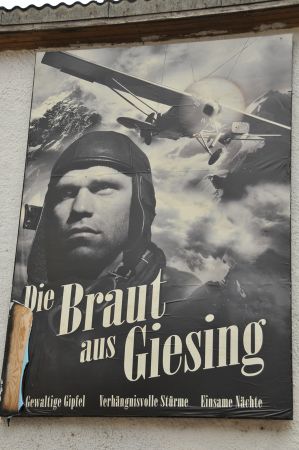 However, on the way and later also in Kallmünz we noticed the high-water marks on buildings and squares, which points to the negative sides of this huge catchment area of the source rivers, so water levels of over 5 meters above the normal river water level were not uncommon, which is what you can see in the current river idyll of course not at all in mind.
However, on the way and later also in Kallmünz we noticed the high-water marks on buildings and squares, which points to the negative sides of this huge catchment area of the source rivers, so water levels of over 5 meters above the normal river water level were not uncommon, which is what you can see in the current river idyll of course not at all in mind.
During lunch in Kallmünz, we were able to talk to a river resident and victim of the last flood in detail.
At water levels of 5 meters, 24 hours' advance warning is hardly sufficient to secure belongings and also to make the building flood-proof. Due to its location between the two rivers Naab and Vils and the steep castle hill, the centre of Kallmünz is almost regularly hit by heavy flooding.
 The Naab arises west of the Upper Palatinate Forest around nine kilometres south of Weiden from the union of the right Haidenaab and left Waldnaab. It then runs south along the A 93 and the B 15, later the B 8, via Schwandorf and Burglengenfeld, among other places. It flows into the Danube from the left at Regensburg-Mariaort, just below the Black Laber and forms a typical river valley with corresponding flora and fauna during its course.
The Naab arises west of the Upper Palatinate Forest around nine kilometres south of Weiden from the union of the right Haidenaab and left Waldnaab. It then runs south along the A 93 and the B 15, later the B 8, via Schwandorf and Burglengenfeld, among other places. It flows into the Danube from the left at Regensburg-Mariaort, just below the Black Laber and forms a typical river valley with corresponding flora and fauna during its course.
- Haidenaab: The right or western source river rises in the Fichtelgebirge.
- Waldnaab: The left or eastern and longest source river rises in the Upper Palatinate Forest.
- Fichtelnaab: A right or western tributary of the Waldnaab rises in the Fichtelgebirge.
- Schweinnaab: A right or western tributary of the Waldnaab. Source about ten kilometres northwest of Parkstein. Estuary in Weiden in the Waldnaab.
- Dürrschweinnaab: The smallest Naab. A right or western tributary of the Sauerbach, into which it flows at Altenstadt-Haidmühle. This is a left tributary of the Schweinnaab.
 We slowly approached the village of Kallmünz, which can be recognized from a great distance due to the ruins of the castle, the former Kallmünz Castle, high above the town.
We slowly approached the village of Kallmünz, which can be recognized from a great distance due to the ruins of the castle, the former Kallmünz Castle, high above the town.
Over the late medieval stone bridge, which was built between 1549 and 1558, we cycle into the town centre. Unfortunately, parts of the stone bridge were damaged by ice in the 18th century and were even blown up by the Wehrmacht at the end of the World War in 1945, so that a modern reconstruction had to take place, which only slightly disturbs the character of the picturesque place.
Old houses with a new look, some of which are crowded under overhanging rocks, give the place a medieval ambience, which reaches its most famous highlight in the house without a roof right in the centre. Here a cave was converted into a house, the entire cave entrance was provided with a wall and associated doors and windows, giving the impression of a cave house comparable to the stone houses in Cappadocia.
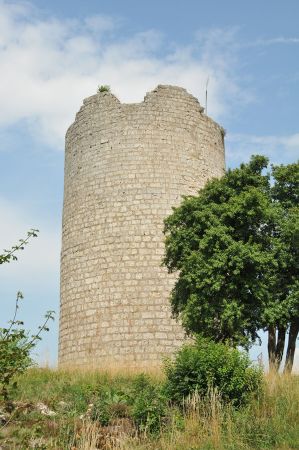 Perhaps it was this building or the entire local ensemble that drew artists to Kallmünz again and again.
Perhaps it was this building or the entire local ensemble that drew artists to Kallmünz again and again.
The painter and professor Charles Johann Palmié, who had travelled from Munich, chose a newly opened inn in Kallmünz as his domicile in 1901 during his summer vacation. He also gave the inn the name "Zur Roten Amsel" and illustrated its exterior facade with his Munich friends al fresco.
The painters Wassily Kandinsky and Gabriele Münter became a couple here during their summer vacation in 1903. Kandinsky then developed a new style of painting, with which he turned away from representational painting and towards the abstract art of "colour tones" (as he put it).
Kallmünz soon became a scenically inspiring attraction for painters, who came here in increasing numbers and some of whom settled permanently. The artist colony soon numbered 38 painters.
 It is less known that famous Berlin painters also visited Kallmünz. Mentioned his at this point Franz Skarbina, a friend of Palmie's who was there in 1901. Magnus Zeller, a student of Lovis Corinth, visited Kallmünz several times during the Third Reich.
It is less known that famous Berlin painters also visited Kallmünz. Mentioned his at this point Franz Skarbina, a friend of Palmie's who was there in 1901. Magnus Zeller, a student of Lovis Corinth, visited Kallmünz several times during the Third Reich.
Today's best-known painter from Berlin, Karl Schmidt Rottluff, was in Kallmünz in the fall of 1936. The important late Expressionist painter Josef Georg Miller lived in Kallmünz from 1944 until his death in a traffic accident. In 1944 he took over a pottery workshop with his wife Erna. After the Second World War, the artists ran a children's home.
From 1979 the painter Hans Geistreiter lived and worked in Kallmünz until shortly before his death. From autumn 1984 he had his own studio for large works. Today there are numerous galleries that show the works of local artists as well as those of guest artists. One can therefore speak of an artists' village without any problem.
 After our tour of the town, we start the march to Kallmünz Castle, which is enthroned high on the mountain spur, the so-called Schlossberg, at about 433 meters above sea level.
After our tour of the town, we start the march to Kallmünz Castle, which is enthroned high on the mountain spur, the so-called Schlossberg, at about 433 meters above sea level.
Directly at the church, however, a steep path leads directly up to the castle ruins. Since the steps of this climb are very high, the alternative path at the end of the village is better for children or older visitors, which is longer in loops but much more comfortable.
After the ascent you reach the breakthrough through the castle wall and get into the extensive areas of the complex. If you have chosen the alternative route, you can reach the inner courtyard directly through the Great Castle Gate.
 The first buildings on the Schlossberg date back to the days of the Celts, as excavations have shown. Even much older structures from the Bronze Age (about 2000 - 1900 BC) have been found here at the confluence of the Naab and Vils.
The first buildings on the Schlossberg date back to the days of the Celts, as excavations have shown. Even much older structures from the Bronze Age (about 2000 - 1900 BC) have been found here at the confluence of the Naab and Vils.
About 1000 meters before the spur tip, a two-phase outer section wall runs over the Hirmesberg, which dates from the Middle Bronze Age around 1600 BC. B.C., and about 100 meters in front of the medieval castle complex, there was also a multi-phase inner section wall from the La Tène period around 500 B.C. BC, which was later built over by the "Hungary Wall". This protective wall, which is still popularly known today as the "Hungary Wall", was probably intended to serve as a retreat for the local population during the Hungarian invasions in the 10th century.
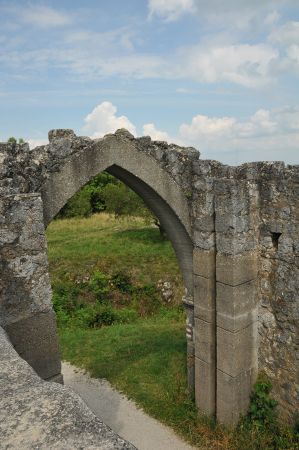 The castle, which is strategically located between the Naab Valley and the Vil Valley at the intersection of several old roads and whose builders are not definitely known, secured an imperial customs post that was described as “old” around 1230. However, it was first mentioned as early as 983 in a document from Bishop Wolfgang. The dating of the older high medieval castle buildings varies from 1150 to 1280. The main castle was at the extreme end of the foothills, directly above the steep drop to the Naab and Vils. The Romanesque building decoration of the polygonal, two-storey palace with coupled arched windows, three-part pointed arched windows, two knights' halls and a castle chapel attached to the north as well as the round 20-meter-high keep with a high entrance at a height of 8 meters, a diameter of 9.5 meters and a wall thickness of about 2.3 meters made of limestone ashlar masonry indicate a construction period around 1170 to 1780. Later additions and remodelling indicate a Gothic construction period. In 1271, a Bavarian ministerial named Hugo von Kallmünz was documented, and in the house contract from Pavia in 1329 the castle was first mentioned as belonging to the Wittelsbach family. Construction measures that Count Palatine Ruprecht I had carried out in 1351 probably related to the 1.2-meter-thick ring wall with its semicircular towers. The late Gothic kennel with gatehouse dates back to the 15th century.
The castle, which is strategically located between the Naab Valley and the Vil Valley at the intersection of several old roads and whose builders are not definitely known, secured an imperial customs post that was described as “old” around 1230. However, it was first mentioned as early as 983 in a document from Bishop Wolfgang. The dating of the older high medieval castle buildings varies from 1150 to 1280. The main castle was at the extreme end of the foothills, directly above the steep drop to the Naab and Vils. The Romanesque building decoration of the polygonal, two-storey palace with coupled arched windows, three-part pointed arched windows, two knights' halls and a castle chapel attached to the north as well as the round 20-meter-high keep with a high entrance at a height of 8 meters, a diameter of 9.5 meters and a wall thickness of about 2.3 meters made of limestone ashlar masonry indicate a construction period around 1170 to 1780. Later additions and remodelling indicate a Gothic construction period. In 1271, a Bavarian ministerial named Hugo von Kallmünz was documented, and in the house contract from Pavia in 1329 the castle was first mentioned as belonging to the Wittelsbach family. Construction measures that Count Palatine Ruprecht I had carried out in 1351 probably related to the 1.2-meter-thick ring wall with its semicircular towers. The late Gothic kennel with gatehouse dates back to the 15th century.
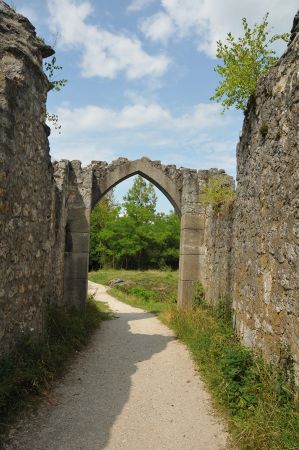 During the Landshut War of Succession, Palatinate troops set the castle on fire in 1504. After its reconstruction in the Thirty Years' War, it was plundered by imperial troops in 1633, finally destroyed by fire in 1641 by Swedish troops and then served as a quarry. In 1793 the castle became municipal property and has been repeatedly renovated since the end of the 19th century.
During the Landshut War of Succession, Palatinate troops set the castle on fire in 1504. After its reconstruction in the Thirty Years' War, it was plundered by imperial troops in 1633, finally destroyed by fire in 1641 by Swedish troops and then served as a quarry. In 1793 the castle became municipal property and has been repeatedly renovated since the end of the 19th century.
There were many other interesting details in the castle complex, which would go beyond the scope of this article. However, all those who are interested should be told that the way up to the castle complex is always worthwhile, especially since the view of the town of Kallmünz and the confluence of the Naab and Vils with the colours of the surrounding forests is really impressive. Colours and shadow situations change depending on the position of the clouds and the position of the sun, even the reflections on the water are impressive. Accordingly, we lingered for a while on a bench directly above the city, which offered this wonderful view.
 For the descent we used the alternative route already described, so that we quickly got back to our bikes. The return trip along the Naab was no longer interrupted by frequent photography, so we were quickly back at the Pielenhofen campsite. A worthwhile day trip by bike, which can also be extended if desired. Highly recommended.
For the descent we used the alternative route already described, so that we quickly got back to our bikes. The return trip along the Naab was no longer interrupted by frequent photography, so we were quickly back at the Pielenhofen campsite. A worthwhile day trip by bike, which can also be extended if desired. Highly recommended.
Please read as well:
Animal welfare: Mistreatment be punished with high fines!
Omis - adrenaline fun in a spectacular canyon landscape
https://www.alaturka.info/en/bicycle-travelling-e-bike-camping/6247-bike-tour-to-kallmuenz-camping-pielenhofen-an-der-naab#sigProId09373e3385
